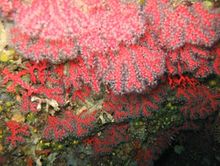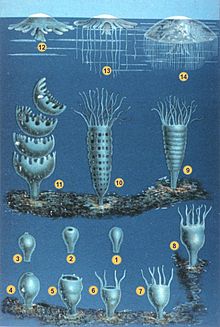Cnidarians
| Cnidarians | ||||||||||||
|---|---|---|---|---|---|---|---|---|---|---|---|---|
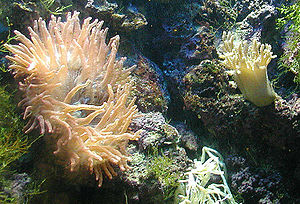
Sea anemone (Actiniaria) and leather coral (Alcyonacea) |
||||||||||||
| Systematics | ||||||||||||
|
||||||||||||
| Scientific name | ||||||||||||
| Cnidaria | ||||||||||||
| Hatschek , 1888 | ||||||||||||
| Classes | ||||||||||||
|
The cnidarians (Cnidaria; old Gr . Κνίδη knidē 'nettle') are simply built, multicellular animals that are characterized by the possession of nettle capsules and inhabit the coasts, the bottom and the open water of the world's oceans and some fresh waters.
Well-known subgroups are umbrella and box jellyfish , the sessile flower animals with the sea anemones , hard and soft corals and the diverse hydrozoa , which also include the state jellyfish and the freshwater polyp native to streams and rivers in Central Europe . They currently comprise over 11,000 recent species. Some cnidarians (such as Polypodium hydriforme and the Myxozoa ) are parasites .
construction
As tissue animals, cnidarians have real tissue and organs . They are built with radial symmetry according to their widely varied basic plan and consist of two cell layers , the outer epidermis or ectodermis and the inner gastrodermis or endodermis . In between is the mesogloea (not to be confused with the mesoderm. Occasionally the mesogloea is regarded as the third cotyledon, but it has nothing in common with the mesodermal blastema of higher metazoa.).

The gastrodermis comprises the “stomach” of the cnidarians, the so-called gastral space (gastrovascular space). It has only one opening through which not only food is taken in, but waste products are also excreted. At the same time, it serves as a hydrostatic supporting skeleton alongside the mesogloea. Hard skeletons, on the other hand, only occur in polyps that specifically deposit lime (e.g. Octocorallia ).
There is no real blood vessel system in the cnidarians. The gas exchange takes place by diffusion , in addition, the so-called gastrovascular system plays a role both for the preprocessing and at the same time for the distribution of nutrients and the removal of metabolic end products: This includes the central cavity, the gastric space and its extensions into the tentacles of the polyps. The gastrovascular system takes on two different functions, digestion and substance transport. Food particles are primarily absorbed by the nutritional muscle cells of the gastroderm.

The cnidarians have real nerve cells that form a diffuse network, which shows only a slight centralization. In polyps, nerve cell concentrations are in the mouth ( hypostome ), on the tentacles and on the foot stalk (pedunculus), in jellyfish there is often a nerve ring around the umbrella. In many cases, a specialized signal transport direction has not yet developed, but the interconnection of nerves via so-called “ gap junctions ” allows some species to conduct excitation at high speeds, and a large number of neuropeptides allow excitations to be modulated. For a long time it was assumed that cnidarians belong to the so-called diploblasts , the dicotyledonous animals. Recent research indicates that cnidarians appear to have a mesoderm in addition to the ectoderm and endoderm . The muscles of the medusa develop from the mesoderm.
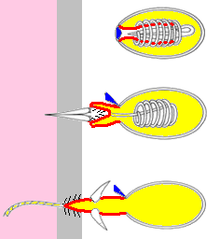
The eponymous characteristic of the cnidarians is a specialized cell type, the nettle cell (cnidocyte). Cells of this type are located on the tentacles around the mouth opening and contain the characteristic nettle capsules (cnids or cnidocysts). These contain a spirally wound nettle thread, which is ejected explosively when touched and injects highly toxic substances into the victim, which quickly kill or at least paralyze them. The nettle cells serve both to catch prey and to defend against predators. All cnidaria have cnidocytes.
Another important cell type are the i- or interstitial cells. These are pluripotent cells , which means that they can transform into other cell types such as sex cells, gland cells or nerve cells, but not into epithelial muscle cells or nutritional muscle cells. The latter two cell types can only emerge from their own kind. Thanks to this system, many cnidarians have an enormous regenerative capacity. In particular, the freshwater polyps of the Hydra genus are used in research as models for pattern formation processes. Interstitial cells are restricted to the hydrozoans and are absent from the other cnidaria.
The two most important types of form are polyp and jellyfish , which can appear as different life stages in one and the same species, so they have no systematic significance.
- Polyps are firmly anchored to a substrate by the so-called basal disk, although some species can also move in strange slow-motion somersaults. Naturally, their tentacles point upwards, away from the substrate. Polyps often appear in large colonies. In summary, a polyp consists of: foot disk (the proximal, aboral) end of the body, a stem, the so-called scapus and the mouth area (peristome) with the only body opening that is surrounded by fang tentacles. Within the 4 groups there are characteristic differences with regard to the septa, which divide the gastric space into individual gastric pockets. Cubozoa and Hydrozoa, which lack these septa, have a comparatively simple structure.
The jellyfish can be derived from the polyps without any problems, as the foot disk and scapus become the upper side, the exumbrella, and the mouth area becomes the lower side, the subumbrella.
- The jellyfish, also known as jellyfish, have a hat-shaped or bell-shaped appearance and mostly swim passively in the ocean currents. Their tentacles hang freely down. However, through coordinated muscle contractions against the water contained in the gastric space, they can also move actively - they use the recoil principle .
Cnidarians show a wide range of sizes: most species are only a few millimeters small, some even smaller. On the other hand, cyanea jellyfish can be two meters in diameter and polyps of the genus Branchiocerianthus can reach the same length. In some species, the tentacles are up to thirty meters long.
distribution and habitat
Cnidarians are found in the sea all over the world, and more rarely in fresh water. Many of them inhabit the open water as jellyfish and are an important part of the zooplankton due to their different larval stages . On the coasts, sessile, mostly colonial cnidarians often dominate the hard floors and, with the tropical coral reefs, created one of the most biodiverse and most productive habitats on earth. The sea feathers also include a group that specializes in soft and muddy seabeds and also inhabits the deep sea and the Southern Ocean.
nutrition
Most cnidarians feed on prey that has come into contact with their tentacles. These are mainly zooplankton animals such as protists , various worms , crabs and other jellyfish . Larger cnidarians also overwhelm larger prey such as fish . Soft corals and gorgonians also catch phytoplankton .
Some groups, including most of the hard corals, but also many soft corals, sea anemones and fire corals, live symbiotically with photosynthetic algae, mostly dinoflagellates (Dinoflagellata), but sometimes also green algae (Chlorophyta). These absorb the carbon dioxide produced by their cnidarians and, using sunlight and releasing oxygen, produce the energy-rich carbohydrates that the cnidarians eat as their main food.
Reproduction
Asexual reproduction by budding is widespread among the cnidarians . It is particularly widespread in the classes of the flower animals (Anthozoa) and the Hydrozoa (Hydrozoa). An asexual larva, the so-called swim bud, separates from the adult polyp at the side and develops into a polyp. Often, budding is incomplete, resulting in physically connected colonies of genetically identical polyps.
However, the cnidarians can also reproduce sexually. A characteristic feature here is the so-called generation change , which is otherwise not as common in animals as in plants, fungi or protists. Generations that reproduce asexually and generations that reproduce sexually alternate. This type of generation change is known as metagenesis .
The adult polyp forms male or female jellyfish in an asexual way. There are three principal asexual processes:
- Budding is particularly common in the flower-animal and hydrozoan classes .
- Strobilation , a process in which jellyfish are constricted in slices at the upper (oral) end of the polyp, is characteristic of umbrella jellyfish .
- Finally, one also finds the complete transformation (metamorphosis) of the polyp into the jellyfish shape - in box jellyfish .
These first develop towards sexual maturity. Then the male and female gametes are released, each uniting to form the zygote . This first develops through cell division into a spherical structure, the so-called blastula , from which the larva, called planula , then arises. This is flagellated and swims until it hits a solid substrate, on which it anchors and then undergoes a metamorphosis to the polyp stage.
This scheme is varied and modified in many ways in the five cnidarians. In many hydrozoans, the jellyfish remain in a reduced form on the polyp, which thus has so-called gonophores . Some hydrozoans, such as the freshwater polyps ( hydra ), do not have a jellyfish stage at all. Instead, the polyp itself forms male or female germ cells. The box jellyfish, in turn, have reduced the polyp stage. There is no jellyfish stage in the flower animals.
Reef formation
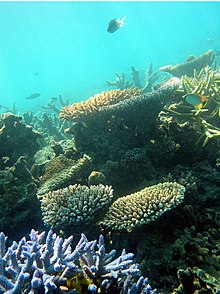
Coral reefs that are built up by a subgroup of cnidarians, the skeleton-forming stony corals , are of great ecological importance . These reefs occur in two ecological areas: on the one hand as deep water reefs in cold water from 60 meters depth, for example along the European continental slope, on the other hand as shallow water reefs in warm seas with water temperatures above 20 ° C. The already mentioned endosymbiotic algae partners are important for their reef formation . Excessive warming often leads to coral bleaching in which the symbiosis was ended by the repulsion of the algae.
Because of the need for sun exposure, coral reefs only exist in tropical waters. The coral polyps secrete there alongside other animals such as certain tube worms , but also various red algae or green algae , lime ( calcium carbonate ) as an outer or exoskeleton , which over time can pile up to form true mountains. As soon as the light output becomes too low - this is definitely the case from a water depth of 60 meters - the corals die, and the following generations have already settled on their skeletons. This allows coral reefs to grow taller as the sea level slowly rises.
Coral reefs are very species-rich ecosystems that also have global effects due to the influence of ocean currents. They are inhabited by a large number of organisms, sponges , various worms , fish , but also algae and various protists .
In geological time, numerous rock formations have formed from the limestone deposited by corals, among other things: For example, the rich deposits of the Eifel and the Bergisches Land go back to hundreds of millions of years old Devonian coral reefs. The Bermuda Islands and the Bahamas are more recent , but also numerous Pacific archipelagos that are based on coral reefs.
Cnidarians as fossils

Cnidarians are a very old group of animals. They are already represented in the so-called Ediacaran fauna of the late Proterozoic about 550 million years ago and are thus among the first known animal fossils. Knowledge of fossil groups is very different depending on the subgroup: While jellyfish consisting of soft tissue have only survived in extreme exceptional cases, the phylogenetic development of corals through the hard calcareous skeletons they left behind is very well known. The first coral reefs therefore come from the geological age of the early Ordovician about 500 million years ago, but the forms at that time still differed significantly from today's corals, which only occurred after the great mass extinction at the end of the Permian 240 million years ago around the middle of the Triassic first occurred about 220 million years ago.
Cnidarians and humans

Cnidarians first of all influenced people by the fact that the latter lived on them: As already mentioned, a number of islands go back to dead cnidarians' skeletons. The limestone they leave behind is commercially mined in many places. In addition, jewelry has been made from special, especially brightly colored corals since prehistoric times.
On the other hand, especially on the north coast of Australia, people regularly die through contact with the stinging cells of highly poisonous jellyfish or are damaged for life by their neurotoxins . The jellyfish found in the North Sea can also cause extremely painful skin injuries.
Conversely, the spread of human tourism often has a very negative effect on the corals belonging to the cnidarians. The coral death that can be observed globally is considered extremely worrying by reef biologists, since corals are key organisms, the death of which often leads to the death of the entire rich ecosystem . In addition to the discharge of nitrate-polluted wastewater, cyanide fishing should also be mentioned here, which can destroy large-scale habitats in a short time. Another danger for corals are the rising water temperatures as a result of climate change: If they exceed a critical limit, the corals often repel their symbiotic algae partners ( zooxanthellae ) and thus bleach. After this coral bleaching, it is difficult for the corals to survive on their own. If the zooxanthellae do not return over a long period of time, the corals die.
Systematics

In the classical system, the cnidarians form a trunk within the tissue animals (Eumetazoa) and were traditionally combined with the rib jellyfish (Ctenophora) to form the group of hollow animals (Coelenterata).
From the point of view of today's predominant systematics, the cladistics , this group is probably paraphyletic, i.e. it does not include all descendants of their last common ancestor: Despite the external similarity of the two taxa , which are noticeable in the two groups own radially symmetrical body structure the comb jellyfish are probably not closely related to the cnidarians, one theory sees them as the closest relative of the bilaterally symmetrical Bilateria , but their actual position in the system is still unclear. From a cladistic point of view, the hollow animals therefore form an artificial group.
The cnidarians are divided into five classes :
- The flower animals (Anthozoa) comprise about 7500 species, including the sea anemones , stone and octocorals . A medusa stage is unknown in this class.
- The pedunculate jellyfish (Staurozoa) are sessile jellyfish with a polyp-like stem. There are about 50 types.
- The box jellyfish (Cubozoa) comprise around 50 species. Among them are the species Chironex fleckeri and Chiropsalmus quadrigatus , known as sea wasps , which have a highly potent venom.
- The umbrella jellyfish (Scyphozoa) include around 200 species, most of which appear as medusa.
- The Hydrozoa (Hydrozoa) are the most diverse group and contain about 3500 species. The spectrum ranges from many jellyfish-like forms to the state jellyfish , the sessile nettle ferns , the tropical fire and filigree corals to the sapling polyps ( Sertularia ), which also occur in the North Sea. The freshwater jellyfish also belong to the hydrozoans. The Hydrozoa often show a generation change between medusa and polyp form.
The parasitic Myxozoa and Polypodium hydriforme , which are the sister group of the Medusozoa, are not assigned to any class .
The probable ancestral relationships of the groups mentioned can be seen in the following diagram:
Cnidaria cladogram according to Collins (2002)
| Cnidaria |
|
||||||||||||||||||||||||||||||||||||
|
|
Individual evidence
- ↑ Marymegan Daly, Mercer R. Brugler, Paulyn Cartwright, Allen G. Collin, Michael N. Dawson, Daphne G. Fautin, Scott C. France, Catherine S. McFadden, Dennis M. Opresko, Estefania Rodriguez, Sandra L. Romano & Joel L. Stake: The phylum Cnidaria: A review of phylogenetic patterns and diversity 300 years after Linnaeus. Zootaxa, 1668: 127-182, Wellington 2007 ISSN 1175-5326 Abstract - PDF
- ↑ Katja Seipel & Volker Schmid (2006): Mesodermal anatomies in cnidarian polyps and medusae. International Journal of Developmental Biology 50: 589-599.
- ^ Robert E. Steele, Charles N. David, Ulrich Technau (2011): A genomic view of 500 million years of cnidarian evolution. Trends in Genetics Volume 27, Issue 1: 7-13. doi : 10.1016 / j.tig.2010.10.002
- ↑ a b Jin-Mei Feng, Jie Xiong, Jin-Yong Zhang, Ya-Lin Yang, Bin Yao, Zhi-Gang Zhou, Wei Miao: New Phylogenomic and Comparative Analyzes Provide Corroborating Evidence that Myxozoa is Cnidaria. Molecular Phylogenetics and Evolution, September 2014, DOI: 10.1016 / j.ympev.2014.08.016
- ↑ Allen Collins et al: Medusozoan Phylogeny and Character Evolution Clarified by New Large and Small Subunit rDNA Data and an Assessment of the Utility of Phylogenetic Mixture Models. (PDF; 2.8 MB), page 108.
literature
- DT Anderson: Invertebrate Zoology. Cape. 3. Oxford Univ. Press, Oxford 2001 (2nd ed.), P. 31. ISBN 0-19-551368-1
- P. Ax: The system of Metazoa I. A textbook of phylogenetic systematics. Gustav Fischer, Stuttgart-Jena 1999. ISBN 3-437-30803-3
- RSK Barnes, P. Calow, PJW Olive, DW Golding, JI Spicer: The invertebrates - a synthesis. Cape. 3.4.2. Blackwell, Oxford 2001 (3rd ed.), P. 54. ISBN 0-632-04761-5
- RC Brusca, GJ Brusca: Invertebrates. Cape. 8. Sinauer Associates, Sunderland Mass 2003 (2nd ed.), P. 219. ISBN 0-87893-097-3
- J. Moore: An Introduction to the Invertebrates. Cape. 4. Cambridge Univ. Press, Cambridge 2001, p. 30. ISBN 0-521-77914-6
- EE Ruppert, RS Fox, RP Barnes: Invertebrate Zoology - A functional evolutionary approach. Cape. 7. Brooks-Cole, Belmont 2004, p. 111. ISBN 0-03-025982-7
- W. Schäfer: Cnidaria, cnidarians. in: Rieger, Westheide (ed.): Special Zoology. Part 1. Protozoa and invertebrates. Gustav Fischer, Stuttgart-Jena 1997, Spektrum, Heidelberg 2004. ISBN 3-8274-1482-2
- B. Werner: 4th tribe Cnidaria. in: v. Gruner (ed.): Textbook of special zoology. Lim. from Kaestner. 2 vols. Gustav Fischer, Stuttgart-Jena 1954, 1980, 1984, Spektrum, Heidelberg / Berlin 1993 (5th edition). ISBN 3-334-60474-8
- Scientific literature
- D. Bridge, B. Schierwater, CW Cunningham, R. DeSalle R, LW Buss: Mitochondrial DNA structure and the molecular phylogeny of recent cnidaria classes. in: Proceedings of the Academy of Natural Sciences of Philadelphia. Philadelphia USA 89.1992, pp. 8750. ISSN 0097-3157
- D. Bridge, CW Cunningham, R. DeSalle, LW Buss: Class-level relationships in the phylum Cnidaria - Molecular and morphological evidence. in: Molecular biology and evolution. Oxford University Press, Oxford 12.1995, p. 679. ISSN 0737-4038
- DG Fautin: Reproduction of Cnidaria (PDF file; 151 kB). in: Canadian Journal of Zoology. Ottawa Ont. 80.2002, p. 1735. ISSN 0008-4301
- GO Mackie: What's new in cnidarian biology? (PDF file; 36 kB) in: Canadian Journal of Zoology. Ottawa Ont. 80.2002, p. 1649. ISSN 0008-4301
- P. Schuchert: Phylogenetic analysis of the Cnidaria. in: Journal for Zoological Systematics and Evolutionary Research. Paray, Hamburg-Berlin 31.1993, p. 161. ISSN 0044-3808
- G. Kass-Simon, AA Scappaticci Jr .: The behavioral and developmental physiology of nematocysts. (PDF file; 3.02 MB) in: Canadian Journal of Zoology. Ottawa Ont. 80.2002, p. 1772. ISSN 0044-3808
- Daly M. et al .: The phylum Cnidaria: A review of phylogenetic patterns and diversity 300 years after Linnaeus. Zootaxa 1668: 127-182 (2007) ISSN 1175-5334
Web links
- Fautin, Daphne G. and Sandra L. Romano. 1997. Cnidaria. Sea anemones, corals, jellyfish, sea pens, hydra. Version April 24, 1997. The Tree of Life Web Project
- Cnidaria picture collection (English)

